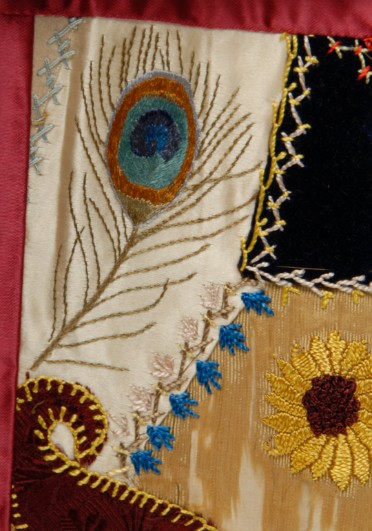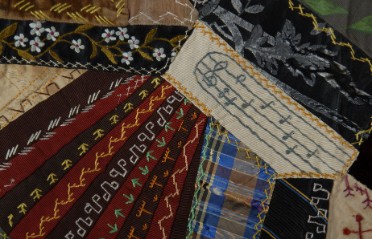Crazy Quilts:The Renderings of Nineteenth Century Quilt Artists.

Reno Gazette
Reno, Nevada
December 8, 1884
Humor of the Day
They used to say "crazy as a bed-bug," but the revised version hath it "crazy as a bed-quilt."
Anyone ever involved in a State documentation project will attest to the volumes of Crazy quilts made between 1880 and 1945. Their proliferation began at a parallel time in our country's history dubbed as the Age of Abundance: the United States from 1877 to 1914. [1] The textile mills of our country were at their peak production capacity, providing an infinite variety of cotton, silks and woolens for clothing and quiltmaking.
The most sited reason for the inspiration of Crazy Quilt making is the art and culture presented in the Japanese pavilion at our country Centennial celebration in Philadelphia. Twentieth and Twenty-first century historians continually repeat that crazed vases displayed in the 1876 exhibit as the origin of inspiration. After reading hundreds of contemporary newspaper articles about Crazy Quilt making, only one referenced it as “Japanese Patchwork.” [2] More often, Crazy Quilt making is recorded as insane, de-mented, and “a fearful thing to contemplate.”[3] Despite the contemporary news article presenting a love-hate relation-ship with Crazy Quilt among the viewing public; quiltmakers persevered.
In reality, Crazy Quilts were just a part of the larger mania sweeping our nation to make quilts of thousands of pieces. The phenomena began in the early 1870s, just prior to the Centennial Celebration. Quilt-makers challenged themselves and one another to make quilts with thousands of pieces. Crazy Quilts and Charm Quilts are just a part of this same craze reflective of the massive amounts of fabric available to sewers. Viewing these multitudinous-pieced quilts, one can only be in awe of the abundance they represent.
The presentation Crazy Quilts: the Renderings of Nineteenth Century Quilt Artists focuses on the humorous aspect of Crazy Quilt making using primary source information from newspapers and poetry contemporary to the quilts. In addition, a large trunk show is provided.
© Sue Reich. All rights reserved. Please seek permission to share this information.
[1] Ray Ginger, Age of Excess: The United States from 1877 to 1914. New York: The MacMillan Company, 1965.
[2] Japanese Patchwork, Burlington Hawk Eye, Burlington, Iowa, October 12, 1882.

